GEO ExPro – a geoscientist peer magazine focused on the energy sector from a subsurface perspective – released a new report that examined in part, the geological opportunities and risks of the Guyana-Suriname Basin. The section on Guyana was penned by Jamie Vinnels and Henk Kombrink.
The Guyana-Suriname Basin is a large offshore sedimentary prospect off the northeastern coast of South America. Recent discoveries attest to estimates of close to 11+ billion proven barrels of oil resources. And the Guyana-Suriname Basin is well on its way to becoming one of the world’s top three deepwater oil provinces, according to 2022 Wood Mackenzie report.
The centre of activity in the Guyana-Suriname Basin is in the southeastern part of the ExxonMobil controlled Stabroek Block in Guyana and Block 58 in Suriname. And the key question now being asked by Geo Expro is “after more than 30 discoveries announced so far, how will the play further develop?” ExxonMobil – the most important operator in the region – recently got approval for drilling of another 35 exploration and appraisal wells “so there surely is additional potential.”
Geo-Expro’s analysis centred on geological opportunities and risks for the Basin, radiating out from the centre of activity.
“The northwestern continuation of the Guyana hotspot was tested by the Tarpon-1 well, which likely drilled the Jurassic syn-rift succession or a carbonate build-up. The results have yet to be announced. In terms of the typical Stabroek play, it is worth noting that canyon cuts have been mapped as far west as the ones shown. These areas may have acted as conduits for reservoirs of a similar nature as the ones discovered to date,” the report outlined.
According to the report, the northward continuation of the Upper Cretaceous Stabroek play was proven by wells Tanager-1 and Bulletwood-1 in the Canje Block but commercial quantities have not been found to date. Thinning of reservoir units in a northerly direction demands the presence of stacked reservoirs. Another play that was tested in this area is a carbonate play, said to be present on top of volcanic centres. The Ranger well targeted this play.
Ranger is in a carbonate play which is more porous when compared to the other discoveries made in sandstone reservoirs. Carbonates are sedimentary rocks deposited in marine environments and are mostly of biological origin. They are made up of fragments of marine organisms, skeletons, coral, algae, and precipitation, and consist mostly of calcium carbonate, which is chemically active compared to the sand which makes sandstones.
Geo Expro found that the main risk exploring the area to the south of the current string of discoveries is the distance from the source kitchen in the north, “i.e. heavy oil and biodegradation, and the potential lack of seal and traps because of the more up-dip nature of the turbidite reservoir sections.”
The report said too that the Guyana Basin makes way for the Demerara Rise in the east, on the Suriname side of the Basin. This area was the first to be explored and drilled in the 1970s, but has not resulted in commercial finds to date. Suriname’s Demerara Play spans some 43,000 square kilometres (km2) with water depths between 500 to 3,000 metres. The area is controlled by Staatsolie and over the last three years only four wells were drilled – GVN-1, ANA-1A, ARA-1 and the Demerara A2-1.
“The source rock in this area is probably an older Jurassic source rock, deposited in failed rift-graben systems intersecting the area. As such, prospectivity also includes older reservoirs such as Jurassic sandstones. Oil slicks mapped in the area provide hints to an active petroleum system,” the report outlined.




